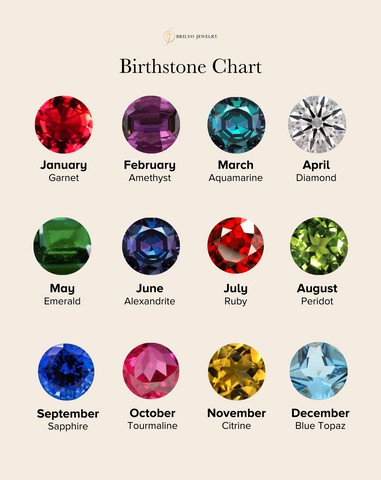Introduction to Birth Month Stones
Welcome to the sparkling world of birth month stones! Whether you’re a parent looking to celebrate the arrival of your new baby or you’re searching for the perfect gift to honor a loved one’s birthday, understanding birthstones is like unlocking a treasure chest of meaning and history. Let’s embark on this gem-filled adventure together!
What Are Birthstones?
Birthstones are precious or semi-precious gemstones associated with the month of a person’s birth. They come in a rainbow of colors and each one holds its own unique significance and lore. These stones have been used for centuries to bring luck, health, and prosperity to those who wear them.
The Significance Behind Birth Month Stones
There’s something truly magical about birthstones. They are more than just beautiful gems; they carry stories, symbolism, and personal connections. Some believe that wearing your birthstone is a symbol of wellness and good fortune. In some cultures, each stone also represents specific qualities that align with the personality traits typical of people born in that month.
January: Garnet – The Gem of Constancy
If your little one is born in the chilly month of January, their birthstone is the rich and resolute garnet. Often found in deep red hues, garnets symbolize peace, prosperity, and health for individuals born in this winter month. It’s a stone that’s believed to keep the wearer safe during travel and is a symbol of enduring affection and devotion.
February: Amethyst – The Jewel of Sobriety
Feburary babies have the regal amethyst as their birthstone. This purple variety of quartz is said to bring clarity of thought and calm the emotions, perhaps much needed in the unpredictable month of February. The amethyst is also reputed to protect against intoxication and to bring about courage and inner strength.
March: Aquamarine – The Stone of Serenity
Aquamarine, with its serene blue color reminiscent of the sea, is the birthstone of March. This tranquil gem represents health and hope. It’s believed to soothe and calm the nerves, which is ideal for those early weeks of adjusting to parenthood with a newborn.
April: Diamond – The Symbol of Invincibility
April showers bring forth diamonds, the most coveted and sparkling of all birthstones. Renowned for their unmatched strength and timeless elegance, diamonds symbolize everlasting love and courage. An April birthstone is a wonderful way to celebrate one of the most precious moments in life – the birth of a child.
May: Emerald – The Embodiment of Rebirth
The lush green emerald is the May birthstone. It represents rebirth and abundance, aligning perfectly with the blossoming of Spring. The emerald is said to grant the wearer foresight, good fortune, and youth. Plus, its rich color is a show-stopper in any piece of jewelry.
As we continue through the calendar, the wonderment of birthstones does not wane. Each month brings a new gem with its own story, which we’ll explore in further detail. So, if you haven’t found your child’s month yet, stay tuned!
The Legacy and Lore of Birthstones
The tradition of birthstones dates back to ancient civilizations. Many historians believe that the concept originated from the Breastplate of Aaron, which contained twelve precious stones representing the twelve tribes of Israel as described in the Book of Exodus. Over time, these stones were linked to the twelve astrological signs, and eventually, the twelve months of the year.
Modern interpretations of birthstones, however, were established more recently, in the 20th century. In 1912, the National Association of Jewelers in the USA standardized the list, making it universal across many countries and cultures. This standardized list has since been adopted by many organizations, including the American Gem Society.
It’s incredible to think how the symbolism of these stones can be passed on like a birthright, from generation to generation. Each stone is imbued with characteristics that resonate with the people born in their specific month.
Diving into birthstones is not just about aesthetics; it’s about forging connections with these timeless treasures of the Earth. So whether you’re picking out a birthstone for a newborn, your own child, or maybe even yourself, remember that these gems are more than just sparkly gifts; they represent a legacy of history, personality, and life’s precious moments.
As we continue our journey into the depths of birthstone lore, we will uncover more about these enchanting gems. From the fiery ruby of July to the icy blue topaz of December, each gemstone carries with it a tale as old as time, waiting to be worn and cherished. So keep on reading as we delve deeper into the world of birthstones and discover the perfect gem that captures the essence of your beloved ones’ birth month.

5 Things Parents Should Know When Preparing for Birth Month Stones
1. Understanding the History and Value
Before you consider purchasing a birthstone, take the time to delve into its history. Understanding where the birthstone originates from, its traditional and modern uses, and its perceived value can make the gift much more meaningful. For instance, knowing that the diamond is not just a symbol of luxury but also of strength and love can give it an additional layer of significance when presenting it to an April-born child.
2. Choosing the Right Jewelry Setting
When selecting a birthstone, think about the most appropriate setting that will complement the gem’s beauty and ensure its longevity. Different settings offer varying levels of protection and presentation for stones. For example, a bezel setting can protect the edges of softer stones like opals or pearls typically associated with October, while a prong setting might best display the brilliance of a diamond.
3. Considering Durability for Daily Wear
Some birthstones, like sapphires and diamonds, are very durable and can be worn daily with little concern for damage. Others, like pearls or opals, are more delicate and require careful handling. When choosing a birthstone for a child, consider a gem that can withstand the adventures and play of daily life, possibly reserving the more fragile stones for special occasions.
4. Birthstone Varieties and Alternatives
Many months offer a variety of stones or have alternative modern birthstones that you can choose from. For example, June’s traditional birthstone is the pearl, but moonstone and alexandrite are also considered acceptable alternatives. This variety gives you flexibility in terms of aesthetics, durability, and price when selecting the right stone.
5. Fostering a Connection with the Stone
Presenting a birthstone to your child is an opportunity to forge a deep, personal connection with the gem. Share with them the stories and meanings behind the stone, and encourage them to cherish it as a representation of their own unique place in the world and within your family. As they grow older, the birthstone can become a cherished heirloom, laden with memories and sentimentality.
Embarking on the journey of selecting a birth month stone is a delightful tradition that can bring joy and meaning to your family’s celebrations. With these handy tips and heartfelt considerations, you’re well on your way to picking the perfect gemstone that your child or loved one will treasure for a lifetime.
Continue to explore each birthstone’s properties and tales as you craft a sentiment that will be appreciated and valued for many years to come. Each gem’s unique beauty and story make it an enduring symbol of the momentous time of one’s birth—a personal and thoughtful tribute to each individual’s entry into life’s precious journey.
See more great Things to Do with Kids in New Zealand here. For more information see here
Disclaimer
The articles available via our website provide general information only and we strongly urge readers to exercise caution and conduct their own thorough research and fact-checking. The information presented should not be taken as absolute truth, and, to the maximum extent permitted by law, we will not be held liable for any inaccuracies or errors in the content. It is essential for individuals to independently verify and validate the information before making any decisions or taking any actions based on the articles.




